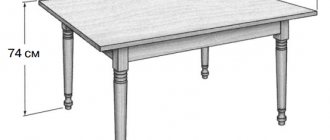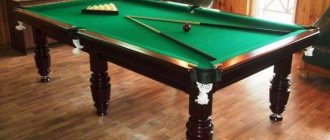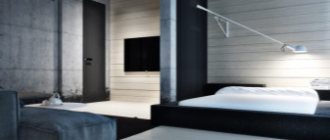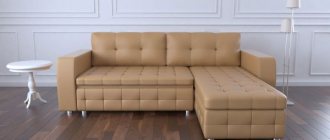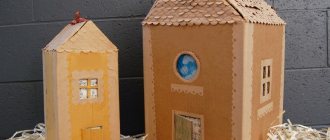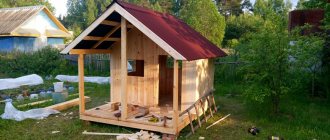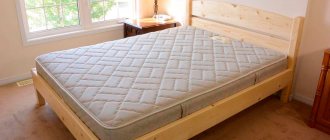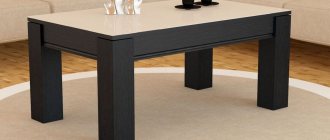A stool is a familiar, comfortable and compact piece of furniture that is most often used in the kitchen or country house. Chairs purchased in a store and made from wood composites do not always meet all consumer requirements in terms of aesthetics and practicality for such conditions, and they are also quite expensive. This is why the question arises of how to make a stool with your own hands from wood so that it is reliable and lasts for many years.
How to make a stool with your own hands
Anyone who started making furniture with such a simple product as a stool, having become skilled at it, may later want to make more complex and large-scale structures, for example, a table, wardrobe or bed, which will save considerable money for the family budget.
Types of stools
Stools or chairs without legs come in different types. A limited number of models are sold in furniture stores. In turn, there are many more types of hand-made stools:
- Classic kitchen stool
- Transformable chair
- Miniature stool
- Bar stool
- Stool with drawers
- Stool with height adjustment
- garden furniture
- Folding model
- Step stool
The most important thing is that you can make a stool of any size and any design, which is clearly illustrated by various photos of hand-made stools from different craftsmen.
Universal solutions
To make a supporting frame, you can easily use metal pipes. Moreover, they can be standard round or profile rectilinear. Thanks to the reliable metal frame, the need to make frames and supports disappears.
If there is a shortage of boards for making a seat, some craftsmen purchase a single sheet of chipboard. This idea for DIY stools has one feature - the sawn slab will definitely have to be upholstered. The second option is to stretch the wire between the drawers. You can place a pillow on this seat to soften sitting time.
Materials for the stool
One of the advantages of making your own stool is that it can be made from any material. Many owners choose environmentally friendly materials:
- Tree
- MDF
- laminated chipboard
That is why the question often arises of how to make a stool out of wood with your own hands. Solid wood is a very expensive material and such furniture is rare on the open market. However, it’s not difficult to do it yourself; you just need to stock up on a few boards. In this case, the boards can be from:
- Pines are the most inexpensive tree.
- Oak or beech - durable tree varieties
- Aspen, ash or linden - their wood is silky and tender. But such wood is short-lived.
In addition to natural wood, you can also use ordinary wood for the stool from old furniture made of chipboard or MDF. For this furniture, you can even use regular plywood or thick cardboard.
Soft cases
You can make capes and covers for stools with your own hands. Soft stools will not only add comfort to everyday life, but also decorate the interior.
In addition to convenience, the use of covers and capes significantly extends the service life of stools. After all, they often not only sit on them, but also stand on them with their feet or use them in some other way other than their intended purpose.
A stool is the most common piece of furniture in every home. Anyone can make it comfortable, beautiful and durable. Don't be afraid to experiment!
Stool Tools
In addition to the materials to create such furniture, you will also need the following tools:
- Pencil, ruler and tape measure
- Jigsaw
- Hammer
- Nails
- Hacksaw
- Sandpaper
- Screwdriver or drill
- Wood glue
Advice. Small tools and parts, such as nails or screws, should be laid out separately on a white cloth - this will make them easier to find and take while making the stool.
Drawings for a stool
Before you start making the product, it is important to think through and calculate the drawings of the stool. It is important to take into account the standard sizes:
- The seat width can be 40-45 cm.
- Seat height – 65-75 cm.
- Height for a bar stool – 90-120 cm.
Height from the floor and seat width are the main dimensions. In addition to them, additional ones need to be taken into account:
- Width and size of legs
- The height of placement of the drawers or crossbars that stand between the legs
- Bottom bars between legs, if planned
- Additional oblique fastenings for drawers
After the drawings are made, it is necessary to transfer them to the material. And then cut wood, chipboard or plywood according to specific patterns.
Advice. For the seat, you can use chipboard or plywood, and for the legs and drawers it is better to use solid wood. You can make a stool entirely from chipboard with your own hands, but this will make the furniture less wear-resistant.
Types of furniture products
Stools can differ in size and appearance, as well as in the materials from which they are made. So, most often they are made from ordinary wood, but there are stools made of metal, plastic, and also those created by combining various materials (for example, the seat can be wooden and the legs can be metal). It is worth noting that, if desired, the seat of the stool can be made soft or simply covered with fabric to give the product a beautiful appearance or achieve a certain level of comfort when sitting on it. The legs may also differ in appearance. There are products with simple, even legs, and there are those whose lower part is a real work of art. It can be patterned, carved and decorated in every possible way.
Products made from natural wood are strong and durable, and also have an original design, which is why they do not lose their popularity
On a note! There are stools that differ in appearance depending on the purpose of their use.
Table. Types of stools.
| Type | Short description |
| Kitchen | This is the simplest and most common option that can be found in many apartments. These stools are used in the kitchen. |
| Bar | Such stools are distinguished by a large seat height, and for a more comfortable position, they have a special foot support underneath. They are used in bars for comfortable seating at a high bar counter. |
| Tourist | This stool is usually foldable and quite durable. Its seat is usually fabric, but is made of durable material that can withstand changes in humidity and temperature. The legs are made of aluminum, which is the lightest type of metal. |
| Musical | This stool is needed specifically by musicians to play musical instruments. It can change its height and also rotate around its axis. |
Children's stool
On a note! In addition to these types of stools, there are also specialized products that differ in certain characteristics (for example, strength, height, etc.). These include children's stools, which are very small in size.
How to assemble a stool
Once the main parts have been cut or created, you can begin to assemble the furniture. The assembly process occurs in the following sequence:
- Each part must be sanded and polished with sandpaper
- Use a pencil to mark places on the legs for attaching drawers or additional parts.
- Once again, try on the height of the legs and drawers, then mark and drill holes for the screws
- Apply glue to the joints of the parts: drawer and legs
- Connect the drawers to the legs
- Install additional fasteners between the drawers.
- Place the seat upside down. Install the legs with drawers on it and secure it.
- Install additional crossbars or other parts between the legs.
- Cover the product with varnish and apply decor.
Marking
We select a suitable piece on the board and measure out a rectangle about 35 cm long on it. We have a future place for the seat. Then we cut off 2 more pieces of 25 cm - these are the legs.
To give them a suitable look, you can draw some kind of pattern. To simplify the work, craftsmen advise using a pattern - a piece of fabric on which all the lines of the pattern will be cut out. We attach the pattern to the board and trace it with a pencil.
For stability, be sure to make a jumper (tsar). The shape is trapezoidal with bases of 220 and 230 mm (so the legs will not be vertical, but at a slight angle, which will increase stability).
Original furniture ideas
The size of the stool depends entirely on the ideas that the owners want to bring to life. In addition to the standard four-legged stool, it can be:
- A small folding chair with three or four legs, which is created from a flexible seat and three base legs.
- Step stool, where an additional step extends
- A transformable chair that can be furniture with a backrest or a stepladder
The most complex design is a transforming chair, the seat of which is made of two halves. One of them can serve as an additional step when turning into a stepladder.
For a step stool, you need to make an additional step, which will be smaller than the seat, and will also have two additional legs. Also, for such a design you will need crossbars with puzzles, with the help of which an additional step will be extended.
Stool decor
After the stool is assembled, the entire product should be processed and stylishly decorated. To make the stool last longer you need to:
- Apply glue to all seams and joints of parts.
- Cover the legs and others with several layers of varnish
- Cover the legs or drawers with painting
- Decoupage the legs and then also varnish them
A stool where the lower part of the legs is painted or covered with decoupage pictures looks stylish.
Advice. Another option for decorating a stool is to decorate the legs in an antique style. This will require additional paint and wax. First you need to paint the edges of the legs with contrasting paint, and then treat it with wax and rub it in. After that, paint again with a different paint. This will create stylish creases and antique cracks.
Manufacturing stages
After all the parts have been marked, you need to arm yourself with a jigsaw and cut out all the elements from wood with your own hands, assembling them and then processing them.
Sequencing:
- We cut out exactly all the details, which is best done on the side of the marking lines. After this, using coarse sandpaper, you should smooth out the sharp corners around the circumference and grind the ends, which will give an attractive appearance while hiding flaws and irregularities.
- Assembly is carried out by connecting the sides with jumpers, placing the structure on a flat surface, after which the cover should be screwed on and the side connections should be strengthened. Knowing how to make a wooden stool, you can create many other original items for your home in the future.
- The parts are carefully sanded with sandpaper or a sanding machine so that after painting no imperfections are visible.
- Painting of surfaces is carried out with a preliminary check and elimination of defects, including the removal of pencil residues. Use a brush to clean the wood dust from the surfaces and begin painting. The choice of color depends on color preferences, but if you want to have a stool in its pure natural form, you can coat it with colorless varnish. For painting, you can use a little paint coated in one layer. Note that poor surface grinding contributes to high paint absorption, for which it is necessary to inspect the product again before painting.
4. Using a jigsaw, cut out the parts
5. Parts are ready
6. Use coarse sandpaper to smooth out sharp corners
7. Sand the parts with fine sandpaper
8. Parts are ready for assembly
9. Assembling the stool – we connect the sides with the jumper (1 screw on each side)
10. Attach the seat and the stool is ready
11. Cover the product with colorless varnish
To make a stool it will take at least two hours, excluding drying time. If you want to create a more complex stool, then you can consider the instructions for a product such as a folding stool.
Seat decoration
The final moment will be the design of the seat. Sitting on a hard chair is very uncomfortable. Therefore, for a stool it is better to choose the following options:
- Static foam seat. To do this, the foam rubber is glued to the seat, and a removable pillowcase is pulled on top.
- Removable pillow with leg ties
- Soft pillowcase with elastic band and foam insert
- Simple Fur Cape
To make the stool comfortable and comfortable, the seat should be soft and well secured: with an elastic band or ties.
Then the guests will be happy, and the household will love this piece of furniture because of its warmth and comfort.
Auxiliary elements
The stool has a simple design - three or four legs and a seat. However, you can add to these elements:
- A drawbar for attaching the legs to each other relative to the seat;
- Upholstery and filling to make the seat soft;
- Legs for improved fixation of the legs together;
- End caps to prevent the stool from rolling around and leaving dents on the flooring.
You can avoid the latter by using insulating tape. It's perfect for wrapping the ends of legs.

